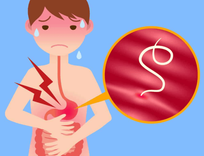Milk aspiration in newborns is a phenomenon where milk flows into the airway, causing difficulty in breathing, choking, and cyanosis, which can lead to respiratory arrest. If not promptly and properly handled, milk aspiration in newborns can be fatal.
1. Recognizing Milk Aspiration in Newborns
Milk aspiration in newborns occurs when milk regurgitates into the airway, causing difficulty in breathing, choking, and cyanosis, which can lead to respiratory arrest. The common causes of milk aspiration are improper feeding positions, feeding while the baby is crying or coughing, excessive milk flow, or using a nipple with a too-large hole, causing milk to flow too quickly for the baby to swallow.
Signs of milk aspiration in newborns include:
- Sudden strong coughing, choking, and cyanosis while feeding or lying down after feeding.
- Sudden crying out loud.
- Milk flowing out of the nose and mouth.
- The baby appears startled, pale, and may become limp or stiff.
- In severe cases, the baby may stop breathing.
- Proper first aid for milk aspiration in newborns is crucial to quickly alleviate the dangerous situation.
2. Is Milk Aspiration Dangerous?
Pediatric experts confirm that milk aspiration in newborns is a common accident in pediatrics. If not promptly and properly handled, it can be life-threatening.
Milk aspiration in newborns can be caused by various reasons, such as improper feeding positions, overfeeding, feeding while the baby is crying, excessive milk flow, or premature birth, which makes the baby more susceptible to milk aspiration.
It is also common in babies with congenital anomalies in the throat area, such as cleft lip and palate.
3. First Aid for Milk Aspiration in Newborns
When a baby shows signs of milk aspiration such as coughing, choking, and cyanosis, parents or caregivers should immediately perform the following steps:
Place the baby face down on your palm and forearm, use the palm of your hand to firmly and quickly pat the baby's back five times to increase chest pressure and expel the milk from the airway.
If the baby still has difficulty breathing and cyanosis, place the baby on a firm, flat surface, use two fingers to press firmly five times on the lower half of the sternum, 1-2 cm below the nipple line. Repeat 5-6 times until the baby shows signs of recovery and the skin turns pink again.
Clear the airway by using your mouth to suck out the milk from the baby's nose and mouth as quickly as possible. Suck from the mouth first, then the nose. If delayed, milk aspiration in newborns can cause airway obstruction due to milk entering the trachea.
For babies who stop breathing: After combining the above measures and clearing the airway, if the baby still stops breathing, perform mouth-to-mouth resuscitation by covering the baby's nose and mouth with your mouth and blowing air in until the chest rises. Continue mouth-to-mouth resuscitation until the baby starts breathing again, then take the baby to the nearest hospital for emergency care.
4. Preventing Milk Aspiration in Newborns
Trắc nghiệm: các chỉ số cần chú ý về sự phát triển thể chất của trẻ
Chiều cao, cân nặng của bé ở từng giai đoạn nên là bao nhiêu là bình thường, bao nhiêu là bất thường? Cùng ThS.BS Ma Văn Thấm điểm lại xem bạn đã nắm được các chỉ số phát triển thể chất của bé chưa nhé!The following content is prepared under supervision of Thạc sĩ, Bác sĩ y khoa, Ma Văn Thấm , Nhi , Phòng khám Đa khoa Vinmec Dương Đông(Phú Quốc)

When feeding a baby, follow these steps:
Hold the baby upright in a comfortable position while feeding, feed the baby slowly and avoid rushing, especially for weak or premature babies. Observe the baby while feeding to ensure the baby swallows all the milk in the mouth before sucking more milk.
If the baby coughs or cries, stop feeding immediately. Allow the baby to swallow all the milk in the mouth before continuing. Do not force-feed the baby. If the milk flows too quickly for the baby to swallow, the mother can use two fingers to pinch the nipple to slow down the milk flow. After feeding, hold the baby upright on your shoulder or chest and gently pat the back to help the baby burp and release air from the stomach, avoiding regurgitation that can cause milk aspiration.
If the baby coughs or cries, stop feeding immediately to prevent milk from continuing to flow into the mouth. If the milk flows too quickly for the baby to swallow, the mother can use two fingers to pinch the nipple to slow down the milk flow.
For bottle-fed babies, ensure the nipple hole is not too large. Tilt the bottle at a 45-degree angle to keep the nipple hole submerged in milk, preventing the baby from sucking in too much air, which can cause vomiting after feeding. When using a spoon to feed milk, pour the milk slowly into the baby's mouth, allowing the baby to swallow before giving more milk.
After feeding, do not lay the baby down immediately. Hold the baby upright for about 20-30 minutes to avoid sudden changes in position that can cause milk aspiration. Let the baby sleep with the head elevated. Do not swaddle the baby too tightly to avoid increasing abdominal pressure, which can lead to milk aspiration and regurgitation after feeding.
Vinmec's Pediatrics Department always brings satisfaction to customers and is highly regarded by experts in the field with:
A team of highly qualified pediatricians (professors, associate professors, doctors, masters) with extensive experience from major hospitals such as Bach Mai, 108, etc. The doctors are well-trained, professional, and empathetic, understanding children's psychology. In addition to domestic pediatricians, the Pediatrics Department also has the participation of foreign experts (Japan, Singapore, Australia, USA) who are always at the forefront of applying the latest and most effective treatment protocols.
Comprehensive services: In the field of pediatrics, Vinmec provides a range of continuous services from newborn care to pediatric and vaccine services, according to international standards, to help parents care for their children's health from birth to adulthood.
Specialized techniques: Vinmec has successfully implemented many specialized techniques to effectively treat difficult pediatric conditions, such as neurosurgery, stem cell transplantation for cancer treatment.
Professional care: In addition to understanding children's psychology, Vinmec also pays special attention to creating a comfortable play environment for children, helping them feel at ease and cooperate during treatment, enhancing the effectiveness of medical care.
To arrange an appointment, please call HOTLINE or make your reservation directly HERE. You may also download the MyVinmec app to schedule appointments faster and manage your reservations more conveniently.

















